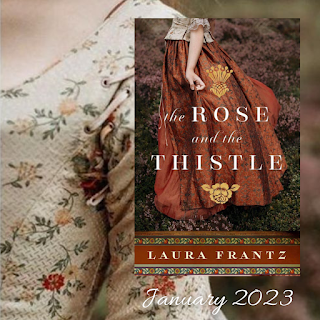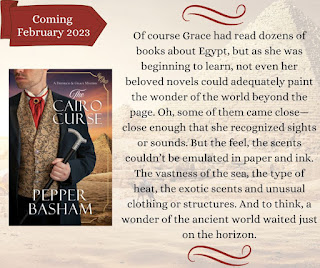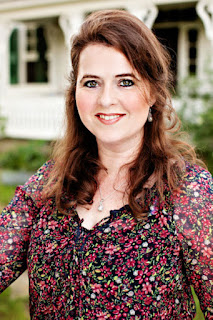(Long post warning...and giveaway) :)
A few months ago I just finished reading an Amelia Peabody book (again) and I am (again) completely captivated by the world Elizabeth Peters created. Now, I only picked it up as research for a book I wrote, but from the first chapter, I was drawn into the setting of Cairo and the arid environment in which Egyptologists and archeologists saturated themselves to uncover ancient relics.
Elizabeth Peters’ book was thick with a world I’d
never experienced, but through her story, I traveled to Egypt, felt the busy-ness
of Cairo’s streets, and even delved into an ancient mystery.
Last night, I finished reading Laura Frantz’s newest
book, The Rose and the Thistle, and I got to traverse the beautiful world of lowlands
Scotland (not too mention the darker and stinkier 18th century
Edinburgh).
How did Laura and Elizabeth help me travel those
places?
And how do we make that happen in our stories?
One of my favorite things in writing (besides
developing characters! I LOVE creating characters!!) is helping my readers get
a sense of place in the storyworld they’ve entered. I adore bringing the
readers into Appalachia or Bath, England, or even my endearing made-up island
of Skymar.
I could really write three separate posts on this
issue, one on each of my points, but I’ll try to sum it up 😊
1. Know
your setting
2. Take
the Organic Approach
3. Move
the senses
First things first, get to know your
setting. Of course, this is for obvious reasons –
if you don’t know your setting, how on earth are you going to describe it for
others?
There are different ways to do this:
A. Traveling
to the places
B. Massive
research
C. The
Author’s own imagination
D. Taking
stories from others and fictionalizing them/or incorporating them into yours
E. All
of the above (or a mixture of a few)
E would be the usual answer 😉
It takes a blend of experiences, knowledge, and
imagination to bring a setting to life in the best ways. But what do we need to
know to impact the setting’s creation?
Oh goodness, I don’t have enough space here to go into
all the possible information, but here are a few questions to ask while shaping
your story world.
What does the place look like? (duh, right?)
What’s the mood of the place? How does it feel? – for
example, in Lord of the Rings, Mordor has a very different “sense” and
weather to it than the Shire. Even the weather sets a tone for the setting in
those two places.
What sort of people live here? Is it a mix of
cultures? Agrarian? A city? The smells, sounds, even the accents are going to
be different, depending on what you choose.
What are the jobs in this setting? A fishing village
by the sea is going to have a different style, flavor, and feeling than an
upscale, city street. A rural area is going to give off a different vibe than a
suburb – not only in what we see, but in what people wear, the way they talk to
each other, and even the pace of life.
What traditions influence the setting and the people?
What is the history of this place? Has it been there a
long time? Were there any significant historical events that took place there? Will
these influence the setting of your story or the people within it?
How about the geography? Having an ocean nearby is
going to create a different culture than being surrounded by mountains. In my
book, The Heart of the Mountains, the culture of the Appalachian
people – isolated within their mountains with limited options for making a
living – are naturally prone to developing and drinking alcohol because the
nature of their environment sets them up for it. So then, how will this
‘culture’ impact my story?
The creation of a world comes from a big pot of
possibilities, and each author attempts to evoke a reader’s imagination in
different ways.
Second (and as important as the first) take
an organic approach to revealing your setting
This may seem a no-brainer, but it’s definitely a shift in writing styles from the 1800s to now 😊 Charles Dickens could spend an entire page describing a cobblestone sidewalk, but readers nowadays are going to skim over that type of intensive detail.
You do NOT have to tell everything you know about this
setting in your book. In fact, please DON’T!! Highlight the best parts
of your setting to build a sense of place, but not bog down your readers with
details. Make the important stuff count.
The best way to do this is weave the setting into the
action of the story, not use it as bookends to a page.
Master storyteller, Jerry Jenkins gives these two
examples:
London in the 1860s was a cold, damp,
foggy city crisscrossed with cobblestone streets and pedestrians carefully
dodging the droppings of steeds that pulled all manner of public conveyance.
One such pedestrian was Lucy Knight, a beautiful, young, unattached woman in a
hurry to get to Piccadilly Circus. An eligible bachelor had asked her to meet
him there.
I get the sense of setting, don you? It works, right?
But…Jenkins gives us an even BETTER way 😊
London’s West End, 1862
Lucy Knight mince-stepped around clumps of
horse dung as she hurried toward Regent Street. Must not be late, she told
herself. What would he think?
She carefully navigated the cobblestones
as she crossed to hail a Hansom Cab – which she preferred for its low center of
gravity and smooth turning. Lucy did not want to appear as if she’d been toseed
about in a carriage, especially tonight.
“Not wearin’ a ring, I see,” the driver
said as she boarded.
“I beg your pardon?”
“Nice lookin’ lady like yourself out alone
after dark in the cold fog…”
“You needn’t worry about me, sir. I’m only
going to the circus.”
“Picadilly, it is, Ma’am.”
Do we still get the same sense of setting? Yes, but we
ALSO experience the story moving forward AND we get a little character
introduction along with a tinge of suspense for icing on the cake.
Now there is nothing wrong with beautiful
prose and descriptions, but they need to have meaning
for your story, not just be words on a page, so they don’t feel like a list of
details. Also, if you’re going to give a longer, meaningful description, try to
alternate it with some action or dialogue.
Thirdly, don’t forget the five senses.
When describing your setting, find ways to incorporate
various types of senses so that the reader can experience the environment too.
Of course, there’s an emotional feeling the setting can create, but there’s
also sight, sound, smell, touch, and taste. We usually don’t use them all at
one time in a description, but it’s fun and interesting to try and find
different ways to use them throughout the story.
Here’s an example from my novel, Laurel's Dream(a descriptive paragraph set within the center of a
chapter).
Laurel hesitated only a second longer
before she headed out the door and down the steep mountain path toward the
church schoolhouse. The trees were only beginning to shift into autumn colors,
with hickory and beech displaying their golden glints first. She breathed in
the earth’s fragrance, still fresh from morning rain, a mixture of wild rose
and moss. Sunlight created a patchwork against the leafy trail as it slit
through the mature forest and led the way down the mountain. Small glimpses of
horizon showed between the trees and offered an endless view to uncharted lands
of colleges and city streets and millions of other things she’d only seen
through the pages of books.
The important things about incorporating the senses is
to keep it organic and relevant to the rest of the story.
As we need to do with almost everything else in story 😊
What are some books you’ve read lately that really took you to a different place? Where did you visit?
Leave your answer in the comments below for a chance to win a paperback copy of my upcoming release, The Cairo Curse (U.S. entrants only).
*********************************************************
Pepper Basham is an
award-winning author who writes romance “peppered” with grace and humor.
Writing both historical and contemporary novels, she loves to incorporate her
native Appalachian culture and/or her unabashed adoration of the UK into her
stories. She currently resides in the lovely mountains of Asheville, NC where
she is a wife, mom to five great kids, a speech-language pathologist, and a
lover of chocolate, jazz, hats, and Jesus. Her novel, Hope Between the Pages,
was a finalist for the prestigious Christy award. Pepper loves connecting with
readers and other authors through social media outlets like Facebook
&
Instagram.
You can learn more about Pepper and her books on her website at www.pepperdbasham.com






Great post, Pepper! I love long posts, and this one is like a mini lesson on the craft of of using setting. We've had such an unseasonably warm winter in Kansas (except for that freaky arctic thing that blew through) that I've already pulled out my beloved copy of The Secret Garden. I read it every spring when the green things start poking up out of the ground. While we're not quite there yet, the robins have come back already, so I'm sure green things can't be far behind. (Yes, I'm well aware that it's still only January.) I love visiting Mary Lennox's little corner of England and would be happy to spend the rest of my days in her secret garden.
ReplyDeleteYou referenced Jerry Jenkins in your post. He is going to be the keynote speaker for the Write to Publish conference in Wheaton, IL in June. Do you think you might go? Are there any other Seekers who be planning to attend?
It's one of those events on my radar for this year, Terri. But I'm not sure I'll be able to make it. Looks like a great conference!
DeleteTerri, I would love to attend one day, but can't go this year. It sounds wonderful.
DeleteI love this post, Pepper! Sometimes I find myself so wrapped up in the story that I forget to use the setting to add depth and richness to the narrative. And this is just what the scene I'm writing today needs.
ReplyDeleteThanks, and I'm looking forward to your new book!
PS - I'm an Amelia Peabody fan, too. :-)
Thanks so much, Jan! Isn't Amelia Peabody SUCH FUN!!!! I always have to go back through these tips when writing too. It's easy to forget when you're trying to wrangle in unruly characters and figure out a plot :)
DeleteHi Pepper, good to see you here. Hope 2023 is good for you. I got so wrapped up in Laurel's Dream....ohhh it was wonderful. I got it in print, Kindle, and also gave it as gifts. I can't wait to read CC and thanks for your giveaway here....please enter me!
ReplyDeleteThanks SO much, Jackie!! I LOVED bringing people into my Appalachian world!
DeleteThis was a great post, Pepper. Please put me in the drawing for the book. I can't wait to continue the series.
ReplyDeleteA wonderfully rich, instructive post! Thanks so much for the shoutout. I do love setting very much, always a character in itself. And you do it so well!
ReplyDeleteGreat post! I just finished The Heart of the Mountains yesterday. Great read, Pepper! Love the realistic struggles and humor you put in your stories. Can't wait to read Freddie and Grace's next adventure!
ReplyDeleteI love that sample you shared from Laurel's Dream. I remember when I was reading that book that I really loved how you described that scene and others. I could picture the trees and leaves and the colors in my mind. As far as another book I have read that gave me a real feel for the setting - The Lost Melody by Joanna Politano really had me feeling the weight and darkness of the asylum. She did a wonderful job making that setting feel so real.
ReplyDeleteOooh, that book has so much atmosphere!!
DeleteWonderfully descriptive post, Pepper. Whether you are creating a fictional locale/kingdom/country or using tried and true New York City, establishing the setting is so crucial. I dislike reading novels that give so little description of the setting, I find it hard to keep myself rooted in the story. The two examples set by Jerry Jenkins demonstrate the elevation of prose bringing the reader right into the actions. AND, Laurel's steps down the mountain path? All the fullness of nature, sweet fragrances and bookish imagination all rolled up into one beautiful paragraph.
ReplyDeletePepper, your teaching skills are as beautiful as your writing. Thank you for sharing!
Audra, the Anonymous
Lovely, Pepper. I could feel your setting. Beautiful covers and wonderful stories! :)
ReplyDeleteI was literally just working on this idea with my 5th grader in our writing class today. I love the contrasting Jenkins examples you gave, bc I think they will resonate with her. She is entering a writing contest and struggles with telling instead of showing, as many her age do. Thanks for this great post!!! I downloaded your Laurel’s Dream because I rarely get to find books with my name in them, but now I think I must move it to the top of my TBR list!!! ~Laurel
ReplyDeleteI'm still reading it right now, but definitely All the Lost Places by Amanda Dykes!
ReplyDeletePepper, I'm just about 1/3 of the way into The Rose and the Thistle, and I fully agree with you. One of the things Laura has done that intrigued me was the clear distinction between citified folks and country folk. She also peels back some of the romantic illusion around Bonnie Prince Charlie. Fascinating work.
ReplyDeleteI love it when an author can do this well. The Colonel’s Lady by Laura Frantz is another example of being pulled right in a time in history and setting.
ReplyDeleteGreat post, Pepper! I finished a couple of books recently that made me yearn to travel. One was The Rose and the Thistle. Although I've been to Scotland, I now want to go back and explore more of it. I also read All the Lost Places by Amanda Dykes. I'd love to see Venice. I learned so much about it in the book.
ReplyDeleteThis comment has been removed by a blog administrator.
DeleteHi Pepper, thanks for this great post! I just finished Within These Walls of Sorrow by Amanda Barratt and I was fully transported to Poland, WWII, and the plight of the Jewish people during that time. It's a powerful story!
ReplyDelete